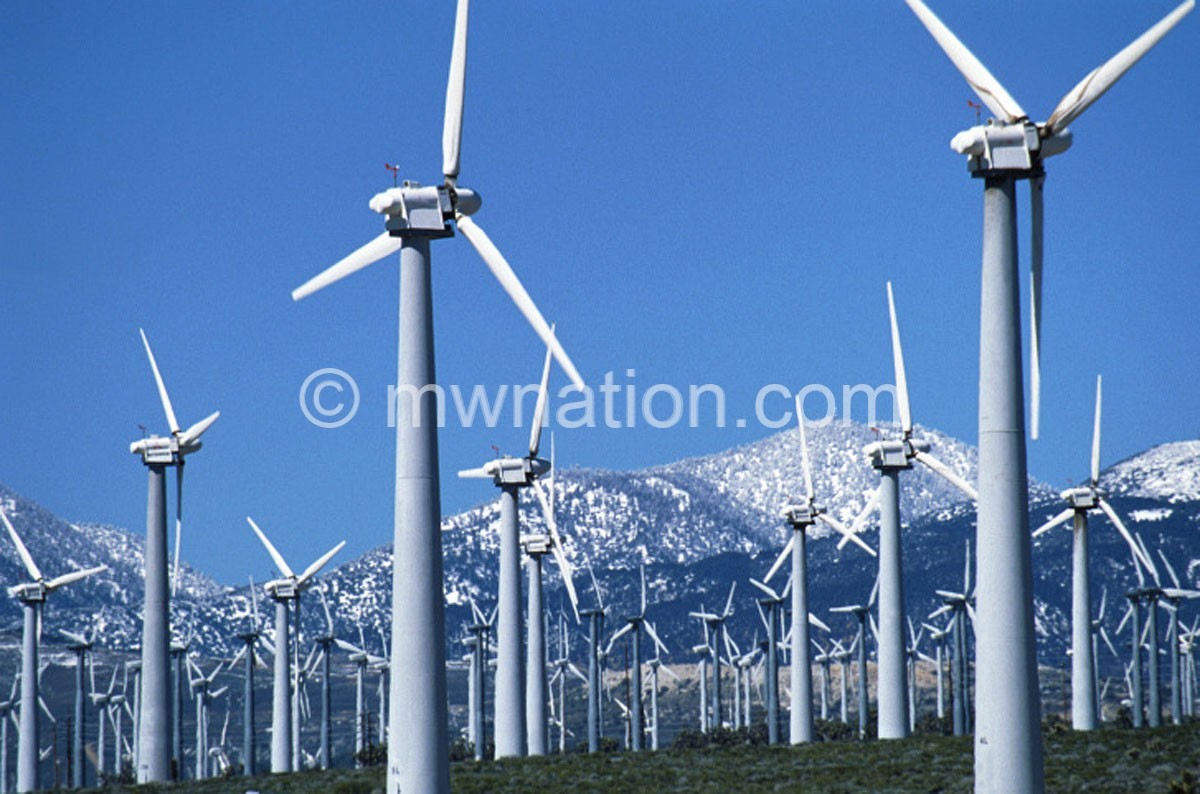Should Malawi look to wind for energy solution?
Energy supply has become a growing concern in Malawi and an important factor towards achieving growth and development.
Future economic growth crucially depends on the long term availability of energy from sources that are affordable, accessible, and environmentally friendly.

However, the country is faced with serious energy supply problems including, rising energy and electricity demand, insufficient power generation capacity, increasing high oil import bills, lack of investment in new power generation units; high transmission and distribution costs, transmission losses; poor power quality and reliability, heavily subsidized pricing; insufficient focus on alternative energy sources; and lack of access to modern electricity for a large segment of the population.
In addition, the country faces a widening gap between electricity demand and supply which is being exacerbated by urbanisation, economic development, population growth and rural electrification.
Electricity demand has been growing consistently at 6 to 8 percent per annum, according to the 2010 Annual Economic Report. As a result, the existing system is greatly strained and the frequency of blackouts over the years has increased constraining industrial production and provision of socioeconomic services as well as deterring foreign investment.
Furthermore, inefficient production and unsustainable use of biomass energy in Malawi is contributing to environmental degradation, such as high deforestation, desertification, and soil erosion.
The use of wood, charcoal and crop residues as fuel also results in indoor air pollution which causes severe human health impacts directly to the users, especially rural women.
Moreover, the task of gathering traditional supplies of fuelwood is time consuming and exhausting. This burden is borne by women and children, who are then diverted from other activities such as education and farming that could eventually have improved their productivity and living conditions.
Thus, improving the energy supply situation and, in particular increasing access to electricity, are of prime concern in Malawi.
When in October 2016, Malawi launched the National Industrial Policy and the National Trade Policy with an aim to support the private sector in furthering economic development, generating employment and reducing poverty, the question of the need for reliable energy supply arose once again.
No investor is interested in establishing a business in an environment where power outages are the order of the day, the Malawi Confederation of Chambers of Commerce and Industry notes in its flagship Business Climate Survey report.
Malawi just like many other African countries relies on hydroelectric power which continues to prove unreliable, due to, among others reasons, natural causes.
Lessons from China
Which is why, countries like China have invested billions of dollars in the area of renewable sources of power including in the less developed provinces.
The idea is not only to woo potential investors into such areas but also people and companies among others, who then provide a market to business available in the areas.
One such province is Inner Mongolia which encompasses green steppe, arid desert and lengthy sections of the Great Wall of China.
In Huitengxile, located in Hohhot, the capital of the province, lies Asia’s biggest wind power plant. It is the biggest wind power plant in Asia. The grassland is located on a highland with a high altitude and abundant wind power.
The giant turbines are visible miles before one reaches them. From a far, the turbines look almost like bleak spikes, horizontally sunk in the green cover like invaders to the beautiful grassy scenery.
As one gets closer, you get to appreciate what the scores of whirring white towers exist for; spinning while harvesting power from the wind. It is a spectacular sight: fields of spinning blades harvesting energy and transforming it into electricity
Since opening in 1996 as an experimental site, there are 96 wind driven generators equipped there.
With random bleating from a herd of Cows and camels roam between the towers, transformers produce the loudest buzz in this grassland as collect electricity from this small legion of the monsters with their spinning blades.
A visit by a group of African journalists learnt that the wind farm is producing 1 gigawatt (1 200 megawatts-MW), powering thousands of households and industries even in neighbouring provinces of Gansu, Ningxia, Shanxi and Hebei.
This is in sharp contrast to Malawi’s situation where hydroelectric power production is at 351MW against the demand of 1 200MW. This means the Huitengxile Wind Power Plant can essentially power and meet the electricity demands of the entire country.
As Huitengxile continues to produce more electricity than it can consume, it is rapidly becoming known as the wind-power center of China. The province is also a leading wind power generator globally according to a 2016 study published in the Journal Nature Energy.
China has plans of generating a quarter of electricity from wind power by 2030.
The farm in Huitengxile just like others in different provinces as well as the entire country has huge goals for wind power development.
“By 2020 we expect to reach 20 000MW. These targets are too conservative, and may be easily surpassed even before that time,” boasted Li Yilun, one of the directors of the Huitengxile Power Plant.
China is still heavily dependent on coal as the main source of energy despite the same being the biggest contributor to air pollution.
But concerns over smog and climate change have prompted a move toward renewables, as have slowing economic growth and a gradual shift in the Chinese economy away from heavy manufacturing and toward consumer industries.
These factors have accelerated the country’s drive towards reducing dependence on harmful energy sources.
“Just like the country, the region still uses coal burning as a source of energy which produces at least 70 percent of the consumed power.
“Our aim is to increase by 30 percent [energy production] from the wind. Combined with solar power and coming in of more power farms within the region and around the country, we are aiming at producing more clean energy. The war on air pollution is no longer a dream but a reality,” said Yilun.
Already, large wind farms are sprouting up in much more heavily populated provinces, such as Fujian, Guangdong and Hebei, while local and foreign turbine manufacturers are competing furiously for the fast-expanding market.
In some coastal provinces, plans are underway to build offshore wind farms in the areas where winds are strong and land use is not an issue. The projects will see the mounting of huge new turbines with 87-yard-long blades, each capable of generating 1 200 MW of electricity, enough to power hundreds of homes as well as industries.
Not so long ago, wind energy was like a fashion house in China—something to show off to the rest of world to prove how green the country was. But now it is part of the country’s energy policy fabric, a serious part of Chinese everyday life. Nothing is considered waste there. Everything is utilised to the zilch.
There have been different studies on different sources of power in Malawi. Wind, solar, geothermal among other renewable energy sources have all been considered.
Malawi situation
However, as it stands, Malawi’s electricity system mainly transmission and distribution need expansion. As of now it can only accommodate 70 megawatts. Thanks to US-funded Millennium Challenge Account (MCA-Malawi) projects are underway to upgrade electricity infrastructure in the country, which once completed, will enable the country to host a number of injections from other sources.
But according to Yilun, wind power is the answer to Africa’s electricity woes especially to low income countries like Malawi.
“Malawi has the potential for wind energy as you have lots of wind. Wind speed is the main deciding factor for a farm as such, wind speed detection for the whole year needs to be done before a wind farm is constructed,” he explained.
However, can a country like Malawi manage to invest and sustain wind power?
“Of course, the major setback is massive investment into such a big project. But I believe Malawi can take advantage of good working relations it is enjoying with countries that have succeeded in wind power energy like China by seeking assistance from it as well as other development partners if it decided to develop that renewable energy source.
“Besides being expensive in the initial investment and maintenance afterwards, but these are the sources that Malawi as a country needs to invest in no matter how expensive considering how unreliable hydroelectric has become with global warming,” explains Yilun.
Energy specialists say Malawi is well endowed with renewable energy resources including reasonable wind speeds for power generation and water pumping. Actually, preliminary results from a wind resource assessment show that there is high potential for wind power generation.
As deputy director of Energy Affairs responsible for renewable energy Joseph Kalowekamo explains: “Malawi is conducting wind resource assessment across the country to come up with a wind resource map. In the first phase, wind speed measuring equipment were installed at Bolero in Rumphi and Chikangawa in Mzimba about three years ago.
“In the second phase, four wind speed measuring equipment were installed in Chitipa, Lilongwe, Dedza and Zomba. They were installed last year. Data collection in these sites is underway. It will be collected for 18 months meaning it will be completed next year. Preliminary results show the country can generate over 60 megawatts from wind.”
Despite the current problems rocking the hydroelectricity in Malawi, he argues that the country will be relying on hydro-powered electricity power for many more years to come.
“Wind cannot replace hydroelectricity now because, though it is being affected by climate change and environmental issues, the potential for hydro is huge in the country. It is about 1 000 megawatts. On the other hand, wind is intermittent; therefore, it can support other power generation technologies such as hydro and coal but not as the main source of power generation.
“With the existing potential, it will be good for Malawi to indeed develop wind farms for power generation to support the hydro generation system. Unlike other power generating technologies such as hydro and coal, this technology can be put up within a short period of time,” Kalowekamo says.
Another alternative for Malawi is coal which is cheap but has a number of environmental issues such that, in most cases it is not encouraged.
Currently, Malawi with support from the Chinese Government is working on its first-ever coal plant at Kam’mwamba.
The China Energy Engineering Corporation, which has no public plans to develop coal power in China, will build a 300MW facility to support Malawi meet half of its electricity demands.





